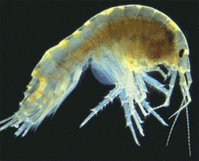
(Source: Biodiversity Institute of Ontario)
| Malacostraca | ||
| Arthropoda | Amphipoda |
| Arthropoda | Peracarida
└─► |
|||
| Ostracoda | None |
Decapoda |
|
Abbreviated Dendrogram
Crustacea
├─Phosphatocopida
└─┬─Branchiopoda
├─Remipedia
╘═╤═Maxillopoda
├─Ostracoda
└─Malacostraca
├─Phyllocarida
└─┬─Hoplocarida
└─Eumalacostraca
├─Syncarida
├─Peracarida
│ ├─Pygocephalomorpha
│ ├─Mysida
│ └─┬─Amphipoda
│ └─Isopoda
└─Eucarida
|
Contents
Overview |
Taxa on This Page
This content on this page copied verbatum from Encyclopedia of Earth - Crustacea under Creative Commons Attribution Share-Alike license. It is intended at some point to add additional material on evolution, paleontology, etc MAK120517
 (Source: Biodiversity Institute of Ontario) |
Amphipods, also known as side-swimmers or scuds, are ubiquitous in marine and freshwater environments. They are small, laterally compressed crustaceans with a shrimp-like appearance, but without a carapace. Amphipods occur in vegetation, under rocks, on sand and burrowing deep in profundal sediments. Most of the 6000 known species of amphipods live in the oceans, but many are also found in freshwater and terrestrial environments. A spectacular evolutionary radiation of amphipods has occurred in Lake Baikal, in Siberia, where there are hundreds of species of amphipods and these animals.
 (Source: Biodiversity Institute of Ontario) |
Amphipods are many-segmented crustaceans. The body is divided into three parts; the cephalothorax, the thorax, and the abdomen. The first thoracic leg is modified into a feeding appendage ("mouth part"), the maxilliped, while the other seven pairs of thoracic legs are used for movement. The first two pairs of thoracic legs are modified for grasping food and are also used by male amphipods to hold onto the female during copulation. The two pairs of antennae are elongate and curved ventrally. Females have a marsupium in which they brood their young until they are ready to be released into the environment.
 (Source: Biodiversity Institute of Ontario) |
The timing of reproduction varies among amphipods. Some species have an extended breeding season, and produce multiple broods, while others have a discrete breeding season and produce only a single brood. Before mating, males of some species such as Gammarus spp. and Hyalella azteca seize females with their gnathopods and hold on for up to a week, waiting for her to moult and be ready for mating. During this time, the pair is said to be in precopula. Copulation consists of the male wrapping the posterior part of his body around the female's ventral side, bringing his uropods in close proximity to her marsupium. He then releases sperm which she sweeps into her marsupium by vibrating her pleopods. After mating is complete, the female releases eggs into her marsupium where fertilization takes place. The incubation period varies with species, locality and time of year.
 (Source: Biodiversity Institute of Ontario) |
The newly hatched young amphipods stay in the marsupium until the female undergoes a post-copulatory moult. The total number of instars (developmental stages) undergone by most amphipod species is poorly known. Amphipods usually only live for one year, though some species, such as Diporeia hoyi, may live for more than two years.
Amphipods can be found in marine and freshwater habitats from shallow, densely vegetated areas, to the deepest ocean depths, sometimes at densities of 10,000 per square metre.
Amphipods are more active at night than during the day. Because many species are scavengers and consume a wide variety of organic detritus, they form an important trophic link within both freshwater and marine ecosystems, recycling organic material which is then passed back up through the food chain. Amphipods are an extremely important food source for numerous species of fishes, as well as for the opossum shrimp Mysis relicta. Due to their importance in aquatic food webs, scientists use amphipods to study the effects of chemical contaminants like PCB's and DDT on aquatic ecosystems.
The swimming speciality of amphipods is a rapid escape response where the abdomen flicks the animal away after the uropods are dug into the ground. - Encyclopedia of Earth - Crustacea
From "Crustacea", Encyclopedia of Earth. Eds. Cutler J. Cleveland (Washington, D.C.: Environmental Information Coalition, National Council for Science and the Environment) 100219; revised 110529; Creative Commons Attribution Share-Alike